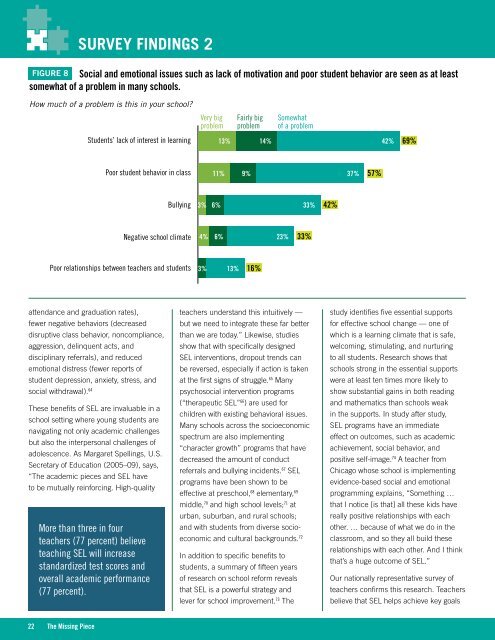CASEL-Report-low-res-FINAL
CASEL-Report-low-res-FINAL
CASEL-Report-low-res-FINAL
You also want an ePaper? Increase the reach of your titles
YUMPU automatically turns print PDFs into web optimized ePapers that Google loves.
22 the Missing Piece<br />
Survey FindingS 2<br />
Figure 8 Social and emotional issues such as lack of motivation and poor student behavior are seen as at least<br />
somewhat of a problem in many schools.<br />
How much of a problem is this in your school?<br />
Students’ lack of inte<strong>res</strong>t in learning<br />
Poor student behavior in class<br />
attendance and graduation rates),<br />
fewer negative behaviors (decreased<br />
disruptive class behavior, noncompliance,<br />
agg<strong>res</strong>sion, delinquent acts, and<br />
disciplinary referrals), and reduced<br />
emotional dist<strong>res</strong>s (fewer reports of<br />
student dep<strong>res</strong>sion, anxiety, st<strong>res</strong>s, and<br />
social withdrawal). 64<br />
These benefits of SEL are invaluable in a<br />
school setting where young students are<br />
navigating not only academic challenges<br />
but also the interpersonal challenges of<br />
adolescence. As Margaret Spellings, U.S.<br />
Secretary of Education (2005–09), says,<br />
“The academic pieces and SEL have<br />
to be mutually reinforcing. High-quality<br />
Bullying<br />
Negative school climate<br />
Poor relationships between teachers and students<br />
More than three in four<br />
teachers (77 percent) believe<br />
teaching SEL will increase<br />
standardized test sco<strong>res</strong> and<br />
overall academic performance<br />
(77 percent).<br />
Very big<br />
problem<br />
3%<br />
4%<br />
3%<br />
13%<br />
11%<br />
6%<br />
6%<br />
13%<br />
Fairly big<br />
problem<br />
9%<br />
16%<br />
14%<br />
Somewhat<br />
of a problem<br />
23%<br />
16%<br />
33%<br />
33%<br />
teachers understand this intuitively —<br />
but we need to integrate these far better<br />
than we are today.” Likewise, studies<br />
show that with specifically designed<br />
SEL interventions, dropout trends can<br />
be reversed, especially if action is taken<br />
at the first signs of struggle. 65 Many<br />
psychosocial intervention programs<br />
(“therapeutic SEL” 66 ) are used for<br />
children with existing behavioral issues.<br />
Many schools across the socioeconomic<br />
spectrum are also implementing<br />
“character growth” programs that have<br />
decreased the amount of conduct<br />
referrals and bullying incidents. 67 SEL<br />
programs have been shown to be<br />
effective at p<strong>res</strong>chool, 68 elementary, 69<br />
middle, 70 and high school levels; 71 at<br />
urban, suburban, and rural schools;<br />
and with students from diverse socioeconomic<br />
and cultural backgrounds. 72<br />
In addition to specific benefits to<br />
students, a summary of fifteen years<br />
of <strong>res</strong>earch on school reform reveals<br />
that SEL is a powerful strategy and<br />
lever for school improvement. 73 The<br />
42%<br />
37%<br />
57%<br />
42%<br />
69%<br />
study identifies five essential supports<br />
for effective school change — one of<br />
which is a learning climate that is safe,<br />
welcoming, stimulating, and nurturing<br />
to all students. Research shows that<br />
schools strong in the essential supports<br />
were at least ten times more likely to<br />
show substantial gains in both reading<br />
and mathematics than schools weak<br />
in the supports. In study after study,<br />
SEL programs have an immediate<br />
effect on outcomes, such as academic<br />
achievement, social behavior, and<br />
positive self-image. 74 A teacher from<br />
Chicago whose school is implementing<br />
evidence-based social and emotional<br />
programming explains, “Something …<br />
that I notice [is that] all these kids have<br />
really positive relationships with each<br />
other. … because of what we do in the<br />
classroom, and so they all build these<br />
relationships with each other. And I think<br />
that’s a huge outcome of SEL.”<br />
Our nationally rep<strong>res</strong>entative survey of<br />
teachers confirms this <strong>res</strong>earch. Teachers<br />
believe that SEL helps achieve key goals


